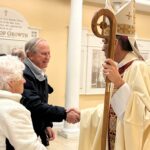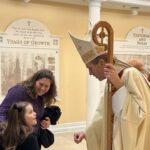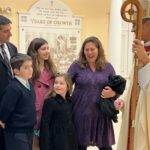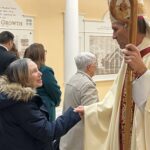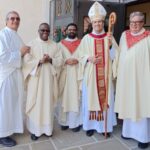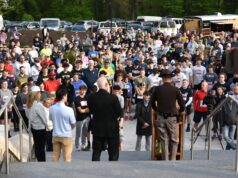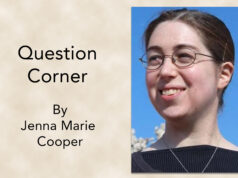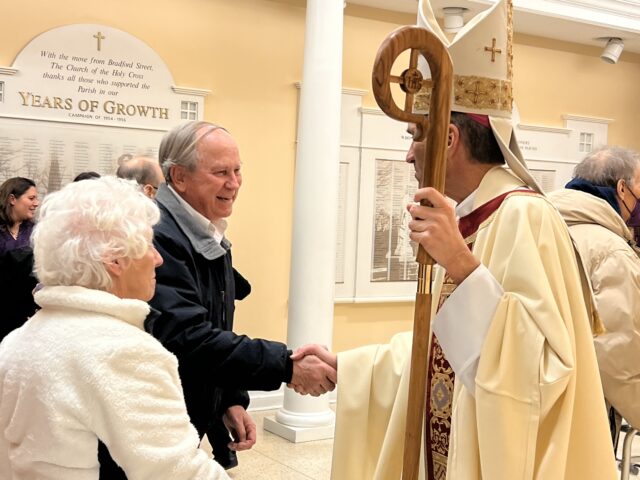
It was 800 years ago today, Dec. 25, 1223, that an event took place in a little town, about an hour outside of Rome, named Greccio that has become a tradition in churches and homes, village greens and, as I’ve seen in my travels to the Eastern Shore of Maryland, even on the sides of busy roads.
It was on that long-ago day, that a little man in a brown habit whom we now know as St. Francis of Assisi, gave instructions several weeks prior to the Christmas that year on how preparations were to be made for the village’s Christmas Eve Mass. The Mass was going to be celebrated in one of the caves surrounding the village and, according to his biographer, Thomas of Celano, St. Francis’ intent was “to bring to life the memory of that babe born in Bethlehem, to see as much as possible with my own bodily eyes the discomfort of his infant needs, how he lay in a manger and how, with an ox and an ass standing by, he was laid upon a bed of hay.”
The manger was constructed and it, along with the two animals, were placed in front of the midnight Mass altar. People gathered and Mass began. And according to St. Bonaventure, St. Francis “stood before the manger, full of devotion and piety, bathed in tears and radiant with joy … Then he preached to the people around the nativity of the poor king; and being unable to utter his name for the tenderness of his love, He called him the Babe of Bethlehem.”
About a certain man named John of Greccio who watched in awe and wonder, St. Bonaventure reports: he saw “an infant marvelously beautiful, sleeping in the manger, whom the blessed Father Francis embraced with both his arms, as if he would awake him from sleep.”
As we gather tonight 800 years later, let us, like the people of Greccio, who stood for the first time 800 years ago before a Christmas manger, stand before the manger that is set up in our church or home and reflect once again upon the reason for the season — the birth of Christ. Let us gaze at the babe of Bethlehem. And in gazing, may two things happen: may we be struck with awe and wonder at what took place in Bethlehem 2000 years ago and in turn, like St. Francis, take Jesus into our arms.
Let us begin by standing in awe and wonder at what angels proclaimed on that first Christmas night: A Savior has been born who is Christ and Lord. Because the Christmas message has been heard by many of us for twenty or thirty or, in my case, a heck of a lot more years, it can become the “same old, same old.” The genius of St. Francis 800 years ago was the way he captured one of the deepest truths of Christmas and that, very simply, is the “how” of God’s entrance into this world.
I have a friend who loves babies. She will lovingly refer at times to the newly-born grandchild of one of her friends as a “little peanut.” Let us be struck with wonder and awe at God’s taking on our human flesh as he is born into this world on this Christmas night not as a mighty ruler and royally-robed king but as a defenseless newborn infant who at one time as he grew within the womb of his mother Mary was no bigger than the size of a peanut. Let us be reminded as we see the poverty of the stable, the darkness of the night, the obscurity of two simple, loving parents, of how our all-powerful and all-knowing God has come into this world. It is by emptying himself and putting himself completely into our hands. And the reason why it takes place this way? It is because of God’s love for sinful humanity that the God of love gives himself completely to us and becomes one of us. It is how Jesus will live his entire life — giving himself completely for us. It is the way ultimately that Jesus’ earthly life will end on the cross as he gives completely of himself and sheds all twelve pints of his blood. Let us gaze in wonder and awe at the mystery of God’s love for each of us that we may be saved.
But let us also know that we are invited to not only stand in wonder and awe but, like St. Francis, to receive Christ.
There is a legend told of the shepherds who visited the newborn child. Upon seeing the child in the manger they presented gifts to his mother. One of them brought the wool that had just been shorn from one his lambs. Another brought produce from his garden. A third shepherd brought a beautiful carved statue of a mother and child. But the last shepherd was very poor and had nothing to give to the newborn king. He felt terribly inadequate and found it almost unbearable to watch as the gifts were being presented. Suddenly Mary looked up at him and, needing to free her hands so that she could receive the gifts, she held the newborn baby Jesus out to him and asked, since his hands were empty, if he, like St. Francis, would not mind holding the infant Jesus. The shepherd could not believe what he was being asked. Tears welled up in his eyes as he lovingly took the child in his arms and realized that he now needed to show the child to the other people who were gathered in the stable. The shepherd had moved from wonder and awe to now accepting the God of Love and allowing others to see.
Tonight and throughout the coming year we and the rest of the world are being invited to receive Christ into our lives. God never forces himself upon anyone. That is not the way of love. But he comes into the world and invites us to receive him. It is a world where there is much to be grateful for. But it is also a world where countries are at war with one another. A world where children go to bed hungry. A world where people can be demonized because of their race or religion. It is a world where we can feel overwhelmed with responsibilities, anxious about the future, burdened with heartache. It is into this world that Jesus is born and offers the way to salvation if we so choose to accept the way of love. Let us remember that God will never force himself upon us. It is not the way of love. May we receive him with open arms.
As we gather this Christmas at the midpoint of our National Eucharistic Revival, let us especially remember and be grateful for the greatest way that Jesus is offered to us and that is through the Mass and Eucharist. It is especially fitting that Jesus, the Bread of Life, was born in Bethlehem, the town whose name means “House of Bread.”
As we gather at Mass tonight and throughout the year, Jesus comes to us in the words of Scripture, in the body of the faithful, in the priestly minister and, most especially, in Jesus’ body and blood that we receive at Communion. Jesus offers himself to us. May we, like St. Francis, receive him with open arms and may we show him to the world. And in so doing, may we give praise and glory to our newborn King.
Bishop William E. Koenig is the 10th bishop of Wilmington.




